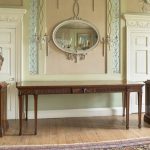The Paxton Style: Neat and Substantially Good
When Trust participants encountered the furnishings for Paxton House in Berwickshire, Scotland, during this year’s “Celebrating Chippendale’s Tercentenary” excursion, the chaste neoclassical pieces seemed a far cry from the gilt, japanned, and inlaid splendor we associated with Thomas Chippendale’s style during our explorations in Yorkshire. In fact, a handful of Chippendale’s most important patrons hailed from Scotland, where tastes often ran to a simpler, more substantial style.
As part of the tercentenary observances of Chippendale’s birth around the British Isles, Paxton House mounted the exhibition The Paxton Style: Neat and Substantially Good to explore the master craftsmen’s Scottish commissions. Furniture historian David Jones produced the accompanying catalog, an effort that was supported, in part, through a contribution from the Decorative Arts Trust. The exhibition focused on objects in the collection of the Paxton Trust, supplemented by loans from institutions and private collections around the U.K. Objects varied from intricately carved dining room sideboards to the basic pine dressers purchased for the servants quarters in the attic. Additionally, pieces no longer extant at Paxton House were represented by loans similar in type and description to the invoices supplied by Chippendale Sr. and Jr.
Jones’ introductory essay explores the correlations between Chippendale’s overall oeuvre and what was produced specifically for the Home family of Paxton House. Scholars have come to call this vernacular “The Paxton Style,” which influenced elite Scottish patrons as well as the cabinetmakers who furnished their houses throughout the last quarter of the 18th century. Although based in London, Thomas Chippendale’s initial business partners were two Scots, James Rannie and Thomas Haig, and a significant number of subscribers to the first edition of the Gentleman and Cabinet-Maker’s Director were Scots.
The neat and plain style spread across the Atlantic to Virginia through the influence of patrons and craftsmen familiar with the taste. By coincidence, Ninian Home, Chippendale’s primary patron at Paxton House, had a direct connection with Virginia. As a young man, he moved to North America to begin his career as the estate manager for his uncle George, a prosperous surveyor in Culpepper Country. Home immersed himself in the daily life and culture of the British colonies, arriving in Virginia in 1749 before relocating to the family’s plantations on the Caribbean island of St. Kitts in 1756 and Grenada in 1764, where he remained for 29 years.
There are distinct and interesting parallels between the language that Ninian selected in ordering furniture from Chippendale’s workshop and the terminology used by the Virginia gentry, including George Washington, a student of George Home. Adam Erby, Associate Curator at Mount Vernon and one of the scholarship recipients on the Chippendale Tercentenary trip, views the parallels as indicative of the common coded language of social standing rather than Home’s Virginia connections. “Britons of every social station” Adam shared, “used coded language to indicate their aesthetic sensibilities to craftsmen and purchasing agents. There was more to furnishing a home than simply picking out the right furniture for a room; each item needed to be appropriate to a person’s station in a hierarchical society and the setting in which it would sit.” According to Erby, two of the terms most frequently used to convey this message were “neat” and “plain.” In an 18th-century context, neat was defined as “elegant, but without dignity” (i.e. rank). Plain meant “simple and void of ornament.” Furniture scholars have often commented on the prevalence of “neat and plain” style furnishings in Virginia, a colony closely tied to Britain through the trade in tobacco, but the style was certainly not unique to the colony. Those terms had broader resonance in the Atlantic World.
Just why Ninian Home chose to install “neat and plain” furniture in his high style house by John and James Adam is unclear. “David Jones’s suggestion [in the catalog] that this has something to do with his connection to Virginia is an intriguing possibility,” Adam says, “but these attributes also seem to have also been key hallmarks of furnishings purchased by the middle classes in London, a woefully understudied topic.” When men like George Washington wrote to their London agents requesting “neat” furniture of a “plain” sort, they were not ordering anything out of the ordinary. Rather, they were purchasing standard items mostly from stock. “What makes Ninian Home’s commission unique is that he applied the ‘neat and plain’ aesthetic of the middle classes to a much higher grade of furniture,” Adam points out. “The result is a beautiful, unique moment in Thomas Chippendale’s oeuvre.”
Paxton House, and its marvelous treasures, was one of 14 British historic sites and institutions commemorating the life and legacy of Thomas Chippendale in 2018. We feel fortunate to have seen so many of his treasures during our in-depth tours this spring! For those who still can’t get enough of Chippendale’s iconic furniture, the website commemorating the 300th anniversary can be found here. Trust members will have an opportunity to visit the Metropolitan Museum of Arts’s Chippendale exhibition in January as part our New York Antiques Weekend program. Stay tuned for more details!
About The Decorative Arts Trust Bulletin
Formerly known as the "blog,” the Bulletin features new research and scholarship, travelogues, book reviews, and museum and gallery exhibitions. The Bulletin complements The Magazine of the Decorative Arts Trust, our biannual members publication.















